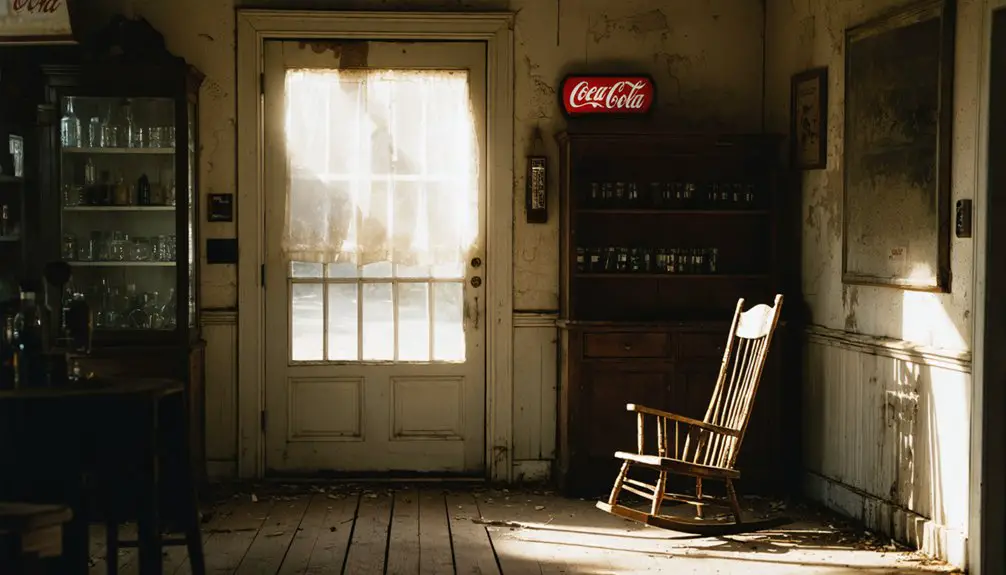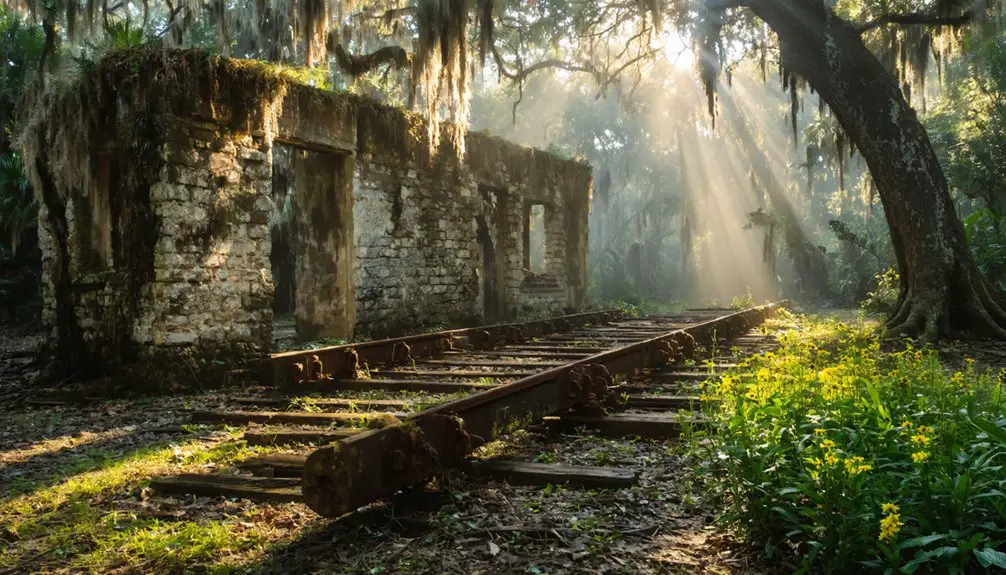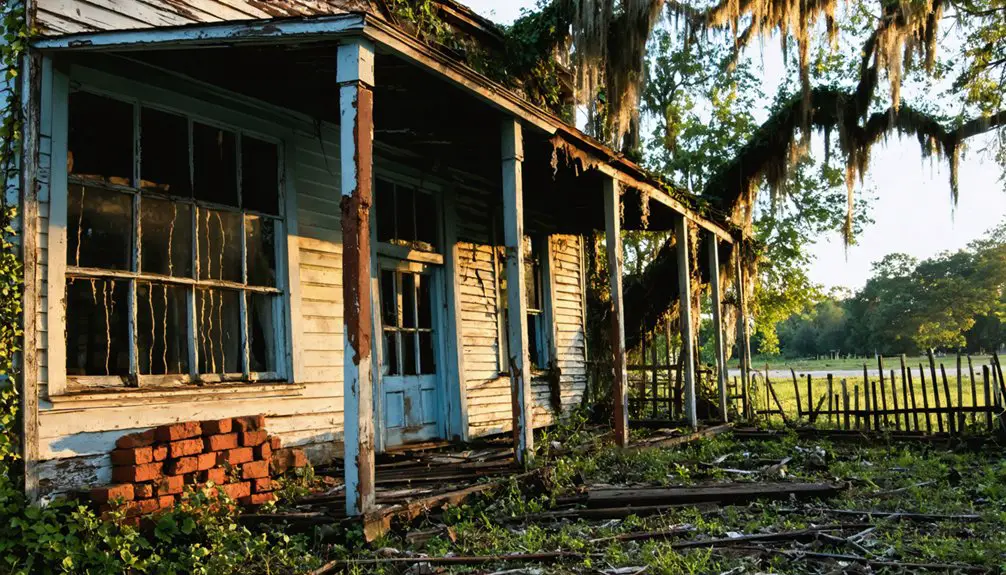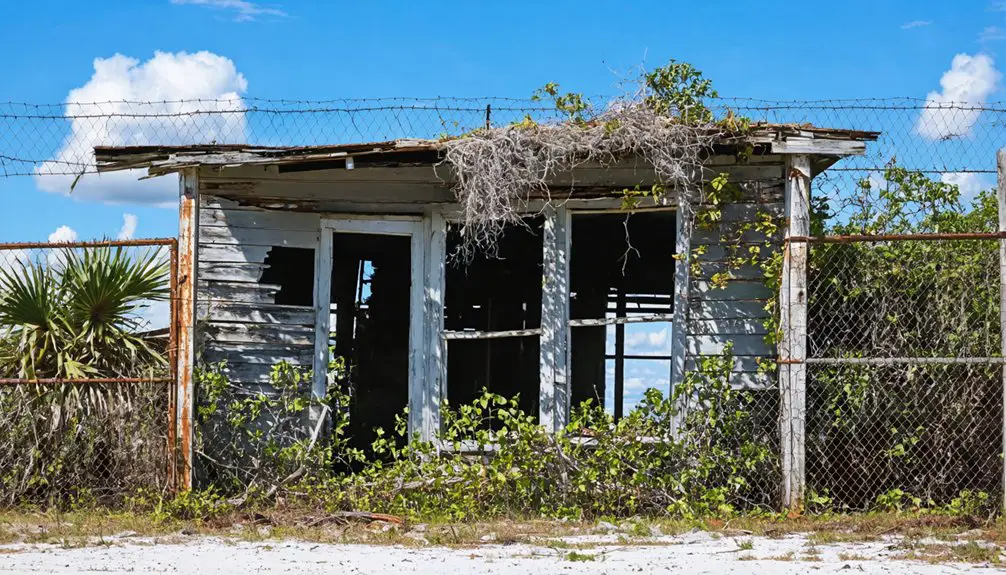You’ll find Willow’s ghost town ruins along the Little Manatee River, where the McGowin-Foshee Lumber Company built a thriving mill town in the early 1920s. The segregated community featured a sawmill, planer mill, turpentine still, and 75-80 worker houses divided by race. While the railroad and mill operations ceased in 1986, scattered remnants of this once-bustling lumber town still whisper stories of Florida’s industrial past.
Key Takeaways
- Willow was established in the 1920s by McGowin-Foshee Lumber Company as a thriving lumber town along Florida’s Little Manatee River.
- The town featured essential infrastructure including a sawmill, planer mill, turpentine still, general store, post office, and railroad depot.
- Strict racial segregation divided the community, with separate housing, schools, and facilities for Black and white residents.
- The town’s decline began after lumber operations ceased, leaving only scattered ruins of the sawmill and commissary.
- Natural regeneration has reclaimed the former town site, with the historic railroad bridge and wildlife corridors remaining as primary landmarks.
The Birth of a Lumber Mill Town
In the early 1920s, the McGowin-Foshee Lumber Company from Alabama established a major lumber operation in Willow, Florida, transforming an undeveloped tract along the Little Manatee River into a bustling company town.
You’ll find the foundations of this lumber production powerhouse took shape in 1923-24 when the company leased 54,000 acres primarily for logging. They built a thorough facility featuring a sawmill, planer mill, turpentine still, and dry kiln. The facility’s unique location allowed workers to create wattle fences from the abundant branches to protect against erosion.
The operation expanded greatly in 1926 when the Robbins family purchased the mill and added 40,000 acres of woodland. As part of the community development, they constructed about 75-80 houses for workers, complete with garden plots. The mill produced various items including cricket bats and furniture from the harvested timber.
The town soon boasted essential amenities including a general store, post office, gas station, and railroad depot with a water tower.
Life in the Segregated Community
If you’d visited Willow during its heyday, you’d have found a town strictly divided along racial lines, with African American workers and their families restricted to living in modest homes clustered near the lumber mill.
Black residents faced stark physical barriers and social boundaries that kept them separated from white areas, including walls and natural buffers that reinforced their isolation from the broader community. Similar to Miami’s Liberty Square projects, these segregated housing arrangements were established through coordinated federal and local policies. The segregated schooling system followed what Bartley calls reading and writing discrimination that severely limited educational opportunities for Black children.
Despite these harsh segregation policies, African American residents built strong social networks centered around their churches, schools, and local businesses, creating a resilient community within the confines of Jim Crow restrictions.
Divided Living Spaces
Life in Willow’s segregated community reflected the harsh realities of institutionalized racism through its deliberately divided living spaces. You’d find physical barriers and walls strategically placed to separate Black and white neighborhoods, enforcing racial isolation and limiting interaction between communities. Public officials actively enforced these discriminatory practices to systematically remove and restrict Black residents.
These segregated neighborhoods weren’t just divided by concrete – they were marked by stark differences in infrastructure, services, and opportunities.
- Six-foot walls and natural barriers screened Black areas from white view
- Limited access points controlled movement between racial communities
- Black residents faced restricted housing options and denied building permits
- Segregated areas often lacked basic municipal services and maintenance
In these divided spaces, you’d witness how urban planning and housing restrictions worked together to enforce second-class citizenship, while Black families struggled against systematic barriers to home ownership and community development.
Daily Social Boundaries
While Willow’s physical barriers enforced racial division, the social boundaries of daily life cut even deeper through the community. You couldn’t access white-only parks, swimming pools, or libraries, forcing your social interactions to remain within designated Black neighborhoods.
Community gatherings and cultural expressions found refuge in segregated spaces you created for yourselves, building self-sufficient institutions that served your needs.
Your daily movements were strictly controlled by Jim Crow laws that dictated where you could work, shop, and gather.
Even professional services required parallel systems – you’d see Black doctors, dentists, and lawyers who established practices within your community.
Despite these harsh restrictions, you fostered vibrant cultural spaces and social networks that strengthened community bonds and preserved dignity in the face of segregation.
Railroad and Transportation Legacy
As the heart of Willow’s development and eventual decline, the Seaboard Air Line Railway shaped the town’s destiny from its founding through its final days in 1986.
You’ll find evidence of this rich rail heritage in the historic metal truss bridge spanning the Little Manatee River and the remnants of the railroad spur that once served the Florida Power & Light plant. Visitors can explore detailed bridge documentation photos showcasing the historic structure’s features.
The historic railroad bridge stands approximately three miles upstream from what is now the state park.
Today, the Florida Railroad Museum keeps this legacy alive through railroad tourism, operating heritage excursions between Parrish and Willow.
- A narrow gauge logging railroad with 3 engines powered the lumber mill’s impressive 50,000 board feet daily output
- The railroad depot and water tower stood as essential infrastructure connecting Willow to South Florida markets
- Vintage Pullman cars from the 1920s-30s now carry tourists along the former rail line
- The 1902-1913 metal truss bridge remains as a tribute to early 20th-century engineering
Economic Operations and Labor System
Since its establishment in the 1920s, the McGowin-Foshee Lumber Company transformed Willow into a classic company town, controlling every aspect of its workers’ economic lives.
Like the early gold miners who hired watchmen for protection in South Pass City, you’ll find the labor dynamics reflected in a workforce of 250 people who operated the sawmill, turpentine still, and logging operations that produced 50,000 board feet of lumber daily.
Similar to how lead ore was exported downstream to the East Coast, the company fostered economic dependency through a scrip payment system that confined workers’ spending to company-owned facilities.
You’d have seen this control extend through every facet of life – from the company commissary and filling station to segregated worker housing that accommodated 75 to 80 families.
This tight grip on commerce even reached into social enterprises, as local establishments, including a house of prostitution, accepted the company’s scrip as payment.
Daily Life and Social Structure

Life in Willow reflected the stark racial divisions common throughout the 1920s American South, with white and black communities occupying separate ends of town and maintaining distinct social spheres.
The black section featured its own cultural hubs, including a church and juke joint, while daily community interactions centered around segregated institutions.
- You’d find 75-80 worker houses with small garden plots where families grew food.
- The company store controlled commerce through scrip payments, limiting economic freedom.
- Black children attended school in Willow, while white children went to Wimauma.
- Churches and social venues were strictly segregated by race.
Family life revolved around the lumber mill’s schedule, with daily routines shaped by work, gardening, and participation in separate community institutions that reinforced the town’s divided social structure.
Architecture and Infrastructure
If you’d visited Willow in its heyday, you would’ve seen a town clearly divided by racial segregation, with white workers’ homes in the south and black workers’ homes in the north, each equipped with small garden plots.
The town’s backbone was its narrow gauge railroad system, featuring three steam locomotives and 30 brakeless logging cars that transported timber to the mill complex. Today, the area serves as a museum and stockyard where visitors can explore the preserved ruins of this once-thriving lumber operation.
The rail infrastructure included a metal truss bridge with distinctive brick piers over the Little Manatee River, which remains as one of the few surviving examples of early 1900s railroad engineering in the region.
Railroad Engineering Features
During the early 20th century, Willow’s railroad infrastructure showcased notable engineering achievements, particularly its metal truss bridge spanning the Little Manatee River. Built by Seaboard Air Line Railroad between 1902-1913, the bridge’s truss design incorporated unique brick piers, demonstrating custom solutions for local conditions.
Today, you’ll find significant structural degradation, especially in the overhead sway bracing and top chord sections.
- Custom-engineered brick piers supporting the metal truss span, rare for Florida bridges
- First railroad route through Manatee County, revolutionizing regional transport
- Six-mile preserved track section from Parrish to Willow for heritage excursions
- Modern maintenance depot with security features protecting historical equipment
While the bridge’s rails have been partially removed since the 1986 abandonment, the structure remains a symbol of early 20th-century railroad engineering innovation.
Housing and Layout Design
Beyond the railroad engineering marvels, Willow’s town layout reflected the social dynamics and industrial demands of early 20th-century Florida.
You’ll find the town was clearly zoned, with housing characteristics that separated white residents in the south from black residents in the north. The town planning centered around 75-80 simple wood-frame houses, each with a small garden plot for workers to cultivate their own food.
At the heart of the community stood essential infrastructure: a general store, post office, and Snowden’s filling station.
You’ll notice how the black section of town contained both the church and school. The industrial zone featured the sawmill, planer mill, and turpentine still, while workers lived in modest homes built specifically for mill employees, reflecting the company town model prevalent in that era.
The Natural Environment

While the ghost town of Willow has long since faded into history, its natural environment tells a compelling story of ecological resilience.
You’ll find the area’s natural regeneration has transformed former lumber tracts into thriving scrub and flatwoods. The Little Manatee River, a pristine blackwater system, flows undisturbed through wildlife corridors that support native species from alligators to diverse bird populations.
- Dense thickets of saw palmettos and scrub pines have reclaimed former residential areas
- The historic railroad bridge now serves as a haven for native flora and fauna
- Untouched wetlands and riparian zones provide critical habitat for Florida’s wildlife
- Natural soil processes have resumed, promoting healthy ecosystem recovery
The land’s remarkable recovery demonstrates nature’s power to heal when left undisturbed by human development.
The Town’s Gradual Decline
As the Great Depression tightened its grip on America in the late 1920s, Willow’s once-thriving lumber industry began its fatal descent. You’d have witnessed plummeting lumber prices that crippled the town’s economic backbone, ultimately forcing the mill to relocate to Tampa in 1937.
The declining population followed swiftly as residents scattered in search of work, leaving behind empty homes and shuttered businesses. The town’s lifeline – the Seaboard Air Line Railroad – gradually reduced its operations, with tracks being removed and transport options dwindling.
These economic shifts dealt the final blow to Willow’s liveliness. By the 1950s, even the post office had closed its doors, and within a decade, the last remaining residents had departed, leaving nature to reclaim what was once a bustling community.
Historical Remnants Today

Today’s visitors to Willow’s forgotten grounds can still find scattered fragments of its once-bustling lumber town heritage.
While nature has reclaimed much of the landscape, historical preservation efforts have helped maintain key remnants of this fascinating ghost town. Community storytelling through oral traditions keeps the town’s memory alive, even as physical structures fade into the wilderness.
- The old sawmill ruins stand as silent sentinels, offering glimpses into Willow’s industrial past.
- A historic railroad bridge spans the Little Manatee River, though it’s no longer accessible.
- The commissary’s remains hint at the town’s former commercial center.
- The Historic Florida Railroad offers guided tours, including stops at a small museum preserving local artifacts.
You’ll find these remnants near Little Manatee River State Park, though reaching them requires determination due to the remote location.
Frequently Asked Questions
What Happened to the Robbins Family After Willow’s Decline?
You’ll find the Robbins legacy faded as they dispersed to other ventures, with William Alfred settling in Brooklyn and others moving to North Carolina timberlands. The family’s disappearance mirrors Willow’s own decline.
Were There Any Major Accidents or Disasters in Willow’s History?
While Willow faced daily risks from logging and railroads, you won’t find records of major accidental fires or train derailments. The town’s industrial hazards surprisingly didn’t lead to documented disasters.
Did Any Famous People Ever Visit or Live in Willow?
You won’t find records of any famous visitors or notable residents in this town’s history. It was primarily populated by lumber mill workers and their families operating in relative isolation.
What Became of the Machinery and Equipment After the Mill Closed?
You’ll find the mill’s machinery disposal was systematic – workers carefully unscrewed and salvaged equipment for resale or reuse elsewhere. Most operational assets, including railroad cars, underwent organized equipment repurposing rather than abandonment.
How Did Residents Celebrate Holidays and Special Occasions in Willow?
You’d have celebrated holiday traditions through church services, juke joint dances, and school events, while special events centered on religious gatherings, community picnics, and neighborhood sharing of homemade foods.
References
- https://en.wikipedia.org/wiki/Willow
- https://www.floridastateparks.org/parks-and-trails/little-manatee-river-state-park/history
- https://www.ghosttowns.com/states/fl/willow.html
- https://kids.kiddle.co/Willow
- https://historicbridges.org/bridges/browser/?bridgebrowser=florida/littlemanatee/
- https://www.fnai.org/arrow-site/history/history-forestry
- https://stars.library.ucf.edu/cgi/viewcontent.cgi?article=4132&context=fhq
- https://files.floridados.gov/media/32347/blackheritagetrail.pdf
- https://www.youtube.com/watch?v=tjanxFXAVM8
- https://artshumanitieshawaii.org/assets/bartley



